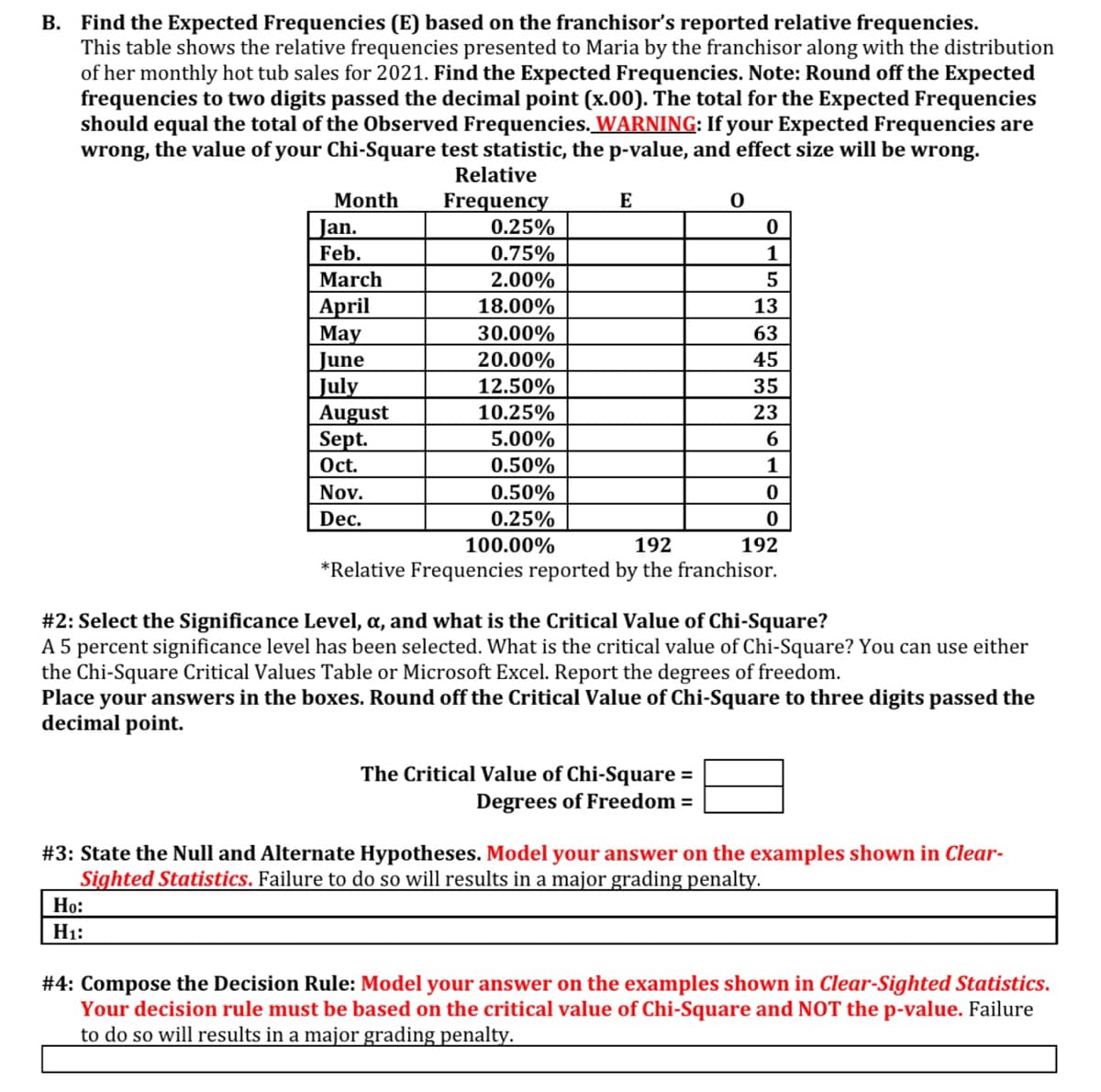B. Find the Expected Frequencies (E) based on the franchisor's reported relative frequencies. This table shows the relative frequencies presented to Maria by the franchisor along with the distribution of her monthly hot tub sales for 2021. Find the Expected Frequencies. Note: Round off the Expected frequencies to two digits passed the decimal point (x.00). The total for the Expected Frequencies should equal the total of the Observed Frequencies. WARNING: If your Expected Frequencies are wrong, the value of your Chi-Square test statistic, the p-value, and effect size will be wrong. Relative Month Frequency 0.25% E Jan. Feb. 0.75% 1 March 2.00% April Мay June July August Sept. 18.00% 13 30.00% 63 20.00% 12.50% 10.25% 5.00% 0.50% 45 35 23 6. Oct. 1 Nov. 0.50% Dec. 0.25% 100.00% 192 192 *Relative Frequencies reported by the franchisor. #2: Select the Significance Level, a, and what is the Critical Value of Chi-Square? A 5 percent significance level has been selected. What is the critical value of Chi-Square? You can use either the Chi-Square Critical Values Table or Microsoft Excel. Report the degrees of freedom. Place your answers in the boxes. Round off the Critical Value of Chi-Square to three digits passed the decimal point. The Critical Value of Chi-Square = Degrees of Freedom = #3: State the Null and Alternate Hypotheses. Model your answer on the examples shown in Clear- Sighted Statistics. Failure to do so will results in a major grading penalty. Ho: H1: #4: Compose the Decision Rule: Model your answer on the examples shown in Clear-Sighted Statistics. Your decision rule must be based on the critical value of Chi-Square and NOT the p-value. Failure to do so will results in a major grading penalty.
B. Find the Expected Frequencies (E) based on the franchisor's reported relative frequencies. This table shows the relative frequencies presented to Maria by the franchisor along with the distribution of her monthly hot tub sales for 2021. Find the Expected Frequencies. Note: Round off the Expected frequencies to two digits passed the decimal point (x.00). The total for the Expected Frequencies should equal the total of the Observed Frequencies. WARNING: If your Expected Frequencies are wrong, the value of your Chi-Square test statistic, the p-value, and effect size will be wrong. Relative Month Frequency 0.25% E Jan. Feb. 0.75% 1 March 2.00% April Мay June July August Sept. 18.00% 13 30.00% 63 20.00% 12.50% 10.25% 5.00% 0.50% 45 35 23 6. Oct. 1 Nov. 0.50% Dec. 0.25% 100.00% 192 192 *Relative Frequencies reported by the franchisor. #2: Select the Significance Level, a, and what is the Critical Value of Chi-Square? A 5 percent significance level has been selected. What is the critical value of Chi-Square? You can use either the Chi-Square Critical Values Table or Microsoft Excel. Report the degrees of freedom. Place your answers in the boxes. Round off the Critical Value of Chi-Square to three digits passed the decimal point. The Critical Value of Chi-Square = Degrees of Freedom = #3: State the Null and Alternate Hypotheses. Model your answer on the examples shown in Clear- Sighted Statistics. Failure to do so will results in a major grading penalty. Ho: H1: #4: Compose the Decision Rule: Model your answer on the examples shown in Clear-Sighted Statistics. Your decision rule must be based on the critical value of Chi-Square and NOT the p-value. Failure to do so will results in a major grading penalty.
Glencoe Algebra 1, Student Edition, 9780079039897, 0079039898, 2018
18th Edition
ISBN:9780079039897
Author:Carter
Publisher:Carter
Chapter10: Statistics
Section10.4: Distributions Of Data
Problem 19PFA
Related questions
Question
Please answer 2,3,and 4.

Transcribed Image Text:B. Find the Expected Frequencies (E) based on the franchisor's reported relative frequencies.
This table shows the relative frequencies presented to Maria by the franchisor along with the distribution
of her monthly hot tub sales for 2021. Find the Expected Frequencies. Note: Round off the Expected
frequencies to two digits passed the decimal point (x.00). The total for the Expected Frequencies
should equal the total of the Observed Frequencies. WARNING: If your Expected Frequencies are
wrong, the value of your Chi-Square test statistic, the p-value, and effect size will be wrong.
Relative
Month
Frequency
0.25%
0.75%
E
Jan.
Feb.
1
March
2.00%
April
Мay
June
July
August
Sept.
Oct.
18.00%
13
30.00%
63
20.00%
12.50%
10.25%
5.00%
0.50%
45
35
23
6.
1
Nov.
0.50%
Dec.
0.25%
100.00%
192
192
*Relative Frequencies reported by the franchisor.
#2: Select the Significance Level, a, and what is the Critical Value of Chi-Square?
A 5 percent significance level has been selected. What is the critical value of Chi-Square? You can use either
the Chi-Square Critical Values Table or Microsoft Excel. Report the degrees of freedom.
Place your answers in the boxes. Round off the Critical Value of Chi-Square to three digits passed the
decimal point.
The Critical Value of Chi-Square =
Degrees of Freedom =
#3: State the Null and Alternate Hypotheses. Model your answer on the examples shown in Clear-
Sighted Statistics. Failure to do so will results in a major grading penalty.
Ho:
H1:
#4: Compose the Decision Rule: Model your answer on the examples shown in Clear-Sighted Statistics.
Your decision rule must be based on the critical value of Chi-Square and NOT the p-value. Failure
to do so will results in a major grading penalty.
Expert Solution
This question has been solved!
Explore an expertly crafted, step-by-step solution for a thorough understanding of key concepts.
Step by step
Solved in 3 steps with 3 images

Recommended textbooks for you

Glencoe Algebra 1, Student Edition, 9780079039897…
Algebra
ISBN:
9780079039897
Author:
Carter
Publisher:
McGraw Hill

Glencoe Algebra 1, Student Edition, 9780079039897…
Algebra
ISBN:
9780079039897
Author:
Carter
Publisher:
McGraw Hill